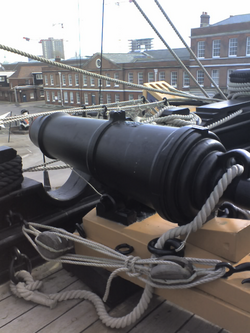
The carronade was a short smoothbore, cast iron cannon, developed for the Royal Navy by the Carron Company, an ironworks in Falkirk, Scotland, UK. It was used from the 1770s to the 1850s. Its main function was to serve as a powerful, short-range anti-ship and anti-crew weapon. While considered very successful early on, carronades eventually disappeared as long-range naval artillery led to fewer and fewer close-range engagements.
Carronade in 1632[]
Carronades were used by the United States of Europe's ironclad and timberclad warships during the war against the League of Ostend. These cannons were very effective in causing heavy damage to 17th century ships, as they threw a much heavier shot than 17th century guns of the same size and weight. This allowed them to play a significant role in the USE Navy's total victory in breaking the Siege of Luebeck.
Unlike the original carronades from the OTL, the ones used by the USE were rifled.[1] The effective range of a USE naval carronade was 400-500 yards, which made it a long-range weapon by the standards of 17th century (or even early-19th century) naval warfare.
References[]
- ↑ 1634: The Baltic War, ch. 38